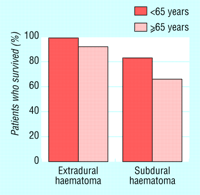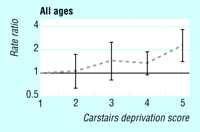This week in the BMJ
Volume 325, Number 7371, Issue of 2 Nov 2002Tricyclics work at low dosages
Free smoke alarm programmes are failing
Age bias exists for older patients with head injury
Epilepsy is linked to social deprivation
International cooperation needed to tackle health inequalities
Doctors are participating in executions
Planned caesarean delivery may prevent deaths of twins
Used mattresses may increase risk of cot death
Tricyclics work at low dosages
Prescribing low dosage tricyclic drugs for depression is justified,
despite criticisms of such practice. In a systematic review of 41 studies Furukawa and colleagues (p 991) found that low dosage tricyclics (between 75 and 100 mg/day, and possibly below this range)
were more effective than placebo. The number needed to treat to
bring about a response in depression was between 4 and 6 at 1-6 months
of treatment.
Free smoke alarm programmes are failing
Providing and installing free smoke alarms to poor urban
households may be a waste of resources. DiGuiseppi and colleagues (p
995) found that giving out free smoke alarms in a deprived, multiethnic, urban community did not reduce fire related injuries or
fires attended by the fire brigade. Few alarms had been installed or were maintained. On page 998 Rowland and colleagues report that
only half of smoke alarms installed in local authority housing were
still working 15 months later. Ionising smoke alarms with long life
lithium batteries were most likely to remain functioning.

Age bias exists for older patients with head injury
Older patients fare less well than the young after a head injury.
Munro and colleagues (p 1001) carried out a prospective national
study of intracranial haematomas in Scotland. They found that although
older patients' rates of survival were still substantial, they
were less likely to receive specialist neurosurgical care than
similarly injured younger patients. This difference persisted even
when previous health, extent of other injuries, and
physiological status on admission were taken into
account.

Epilepsy is linked to social deprivation
People who are socially and economically disadvantaged are more likely
to develop epilepsy than those who are not. Heaney and colleagues
(p 1013) identified all new cases of epilepsy in 20 general
practices and found the age and sex adjusted incidence in the most
deprived fifth of the study population was 2.3 times that in the least
deprived fifth. The results may partly reflect differences in the
incidence within and outside London.

International cooperation needed to tackle health inequalities
International exchange and collaboration is necessary to help reduce
health inequalities, report Mackenbach and Stronks (p 1029). They
describe a unique, research based approach by the Netherlands Ministry
of Health, in which 12 different interventions were tried and evaluated
and a strategy to reduce inequalities by 2020 was devised. The strategy
covers four different entry points for reducing socioeconomic
inequalities in health, containing 26 specific recommendations and 11 quantitative policy targets. The authors say that international
agencies such as the European Union have an important role in
supporting such collaboration.
Doctors are participating in executions
The explosive growth in the number of executions in the
United States over the past two decades correlates with the acceptance of lethal injection as the preferred method. Lethal injection is unique
among execution methods because it simulates a medical procedure and
because doctors often have to be involved. Medical professionals'
organisations in the United States forbid participation in executions,
says Groner (p 1026), but most doctors are not aware of these
guidelines and are willing to participate.

Planned caesarean delivery may prevent deaths of twins
Planned caesarean delivery may be protective against perinatal death
among twins, especially for the second twin. Smith and colleagues (p
1004) report data from the births of over 4500 twin pairs and show
significantly increased risks of intrapartum stillbirth and neonatal
deaths in second twins born at term. Intrapartum anoxia caused three
quarters of deaths in second twins, mostly due to anoxia resulting
from mechanical problems after vaginal delivery of first twins.
Used mattresses may increase risk of cot death
Babies who routinely sleep on an infant mattress previously used by
another child may be at increased risk of cot death, particularly if
the mattress was from another home. Tappin and colleagues (p 1007) also
show that the association is particularly high if the infant was
sleeping on the used mattress at time of death. However, insufficient
evidence is available to judge whether this is a cause and effect relation.